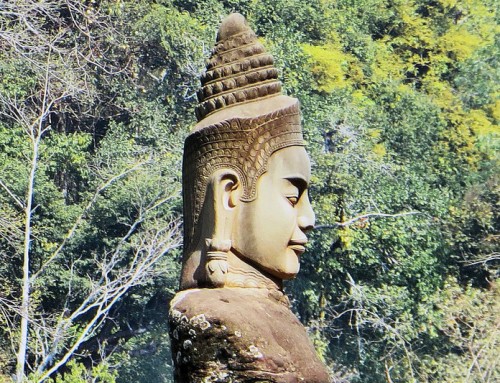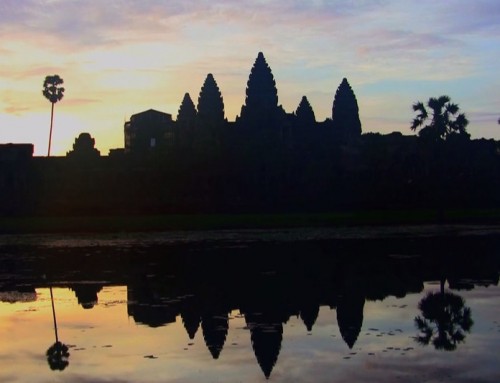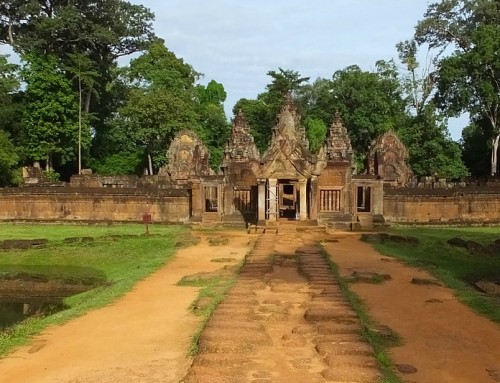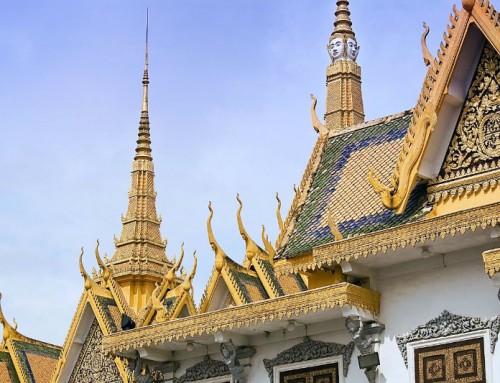
Hanoi D
After immigration and customs clearance meet the assigned tour guide and transfer to the hotel.
Check in time is normally at 14:00, however the guests will be accommodated as soon as the rooms become available.
Visit the capital of Vietnam has been inhabited since the third century and re-founded in the eleventh century by the dynasty that freed the country from Chinese rule,
His look dates back to the French times with the numerous colonial buildings and large avenues.
Visit the Lake of the Restored Sword and the Temple of Literature, the One Pillar Pagoda, Ho Chi Minh Mausoleum (from outside), walking tour through the Old Quarter.
water puppet show and dinner at local restaurant.
Overnight.
Day 02
Hanoi – Halong B, L, D
Breakfast.
Departure by land through the countryside of the great delta furrowed by the waters of the Red River and Thai Binh .
Along the route of about 170 Km, enjoy the beautiful views of picturesque inland ports, edged karst hills , in the midst of an agricultural landscape .
Arrive at Halong Bay , on the shores of Tonkin , that rightly celebrated the ranks of one of the most famous natural landscapes of the Far East .
Boarding for the cruise and ride in a boat to experience the legend of Halong Bay (“Place of the dragon plunges”): 3000 islands shaped by the action of geological and tropical rains and typhoons: rocks of bizarre shapes, sculptures of limestone, cliffs, fjords, caves, small beaches and harbors are reflected in a cobalt sea crossed by old junks , the slight oval boats with rigid sails, characteristics of the region.
Lunch and dinner will be served on board and will be based on tasty fresh seafood .
Overnight on board the junk.
Day 03
Halong – Hanoi – Hoi An B, Brunch, D
Breakfast.
In the morning, after breakfast, leave the junk and on small local boats called Sampan, start to visit the cave of Surprise with the opportunity to bathe in small deserted beaches.
While navigating, see some caves and spectacular scenery of limestone formations that emerge from the sea.
Brunch on board.
Return to Hanoi in the afternoon, transfer to airport and departure by scheduled flight to Da Nang.
Proceed immediately to Hoi An (30 minutes), accommodation.
Dinner at hotel
Overnight.
Day 04
Hoi An – Danang – Hue B, L, D
Breakfast.
Guided walking tour of the old town of Hoi An, one of the most precious jewels of the Vietnamese historical heritage and rightly included among the UNESCO World Heritage Sites. With perfectly preserved old buildings, in its perimeter cars are not allowed. The Japanese Bridge is characteristic and famous, it was built in the 16th century in the style of a pagoda. Stops at temples, the buildings of the congregations andprivate homes are still inhabited by descendants of the original owners.
Chance to go to the discovery of numerous studies of artists who have chosen to live and work here, making Hoi An one of the most lively cultural and artistic centers of the country. Transfer to Da Nang to visit theCham Museum, a series of well-designed pavilions that house the more complete and comprehensive historical artifacts exhibition of the Cham kingdom, which developed in the area between the second and the fifteenth century AD
Beautiful sandstone sculptures from.VI-XV cent. testify to the importance of this culture. About 100 kilometers separate from Danang Hue, and the route is particularly impressive. After a stretch of coastline the road climbs up to the Pass of the Clouds. On both sides there is a magnificent panorama of Danang, the coastal headlands and
the bays to the south. Panoramic views from the valley to the coastal plain, between the lagoons and paddy fields. The step also dominates the two most beautiful beaches of Danang, Nam O in the south and Long Co facing the north: there are crescents of white sand fringed with palm trees. Arrive in Hue, which is situated on both banks of the Perfume River. It was the ancient capital of Vietnam during the Nguyen dynasty emperors (1802-1945). It was surveyed by UNESCO as a World Heritage Site.
The archaeological complex of Hue is closed in three concentric circles where pagodas, tombs, palaces and gardens are arranged according to the cosmological principles of geomancy. They are shelters against the dark forces of nature and bad luck.
Lunch at local reataurant and dinner at hotel.
Overnight.
Day 05
Hue – Ho Chi Minh B, L, D
Breakfast.
Visit of the historical center, the Citadel, with its high bastions of stone, the yellow tiles protruding roofs with red wooden pillars.
Inside find the Purple Forbidden City, the exclusive domain of the emperors, the vast Thai Hoa Palace (Supreme Harmony), which was the site of official and religious ceremonies , the Halls of the Mandarins, the Imperial Library, the Royal Theatre. The Imperial Museum completes the tour of the Citadel: old clothes, furniture, porcelain, and sedan chairs together with musical instruments are on display in a beautiful room. Boat trip on the picturesque Perfume River, among the numerous fleets of
sampan, for a visit to one of the tombs of the Nguyen emperors which are scattered among the hills south of the city, with their statues and pagodas destined to the cult of the dead king.
Visit the Dong Ba market.
Departure by scheduled flight from Hue to Saigon.
Renamed Ho Chi Minh City to honor the father of national independence, Saigon however is free from any attempt to homologation in the ideological and austere North, and is the extroverted and vital metropolis as ever was. Seven million people live in twelve urban districts, the first of which corresponds to the center
set at the end of the last century by the French around three major boulevards perpendicular to the river port. Along the streets, where there is most of the city life, there is a myriad of shops, stalls, carts and street vendors that sell the merchandise by exposing on the sidewalks.
Lunch at local reataurant and dinner at hotel.
Overnight.
Day 06
Ho Chi Minh – Cu Chi – Ho Chi Minh B, L, D
Breakfast.
In the morning excursion to the Cu Chi tunnels, dug over 200 km underground tunnels on three levels, which allowed the Viet Cong and the people of the villages in the area to escape the bombing raids of the Americans during the war. Before the visit, you will have the opportunity to attend a screening of vintage films that illustrate the construction of the tunnel and the life inside them,
They are very useful to understand not only the development of the war in this particular area, but also some essential aspects of the Vietnamese mentality.
In the afternoon visit of the “White City,” the heart of the world colonial Indochina.
The Rue Catinat was a stage of the ‘white city’, which preserves part of the character of the past days with its silk and souvenirs shops, the lacquers and prints shops, the dealers of antiques, art galleries and cafes. Visit some of the colonial buildings such as the Cathedral of Notre Dame, an elegant fusion of red brick and white stone, which overlooks a large tree-lined square, and the Post Office Palace with the rich and abundant bas-reliefs of the colonial era, the delicious windows with shutters and a large vaulted room similar to those of a Victorian railway stations.
The War Museum is designed as a denunciation of American aggression in Vietnam and presents very raw photos and a collection of weapons including fighter planes. Visit Visit Cholon, the Chinese district, with its path along the crowded streets where mainly imported from China products aresold, most notably those made from herbs and the traditional medicines.
Lunch and dinner at local restaurants.
Overnight.
Day 07
Ho Chi Minh – Delta Mekong – Chau Doc B, L, D
Breakfast.
Morning departure by road to Cai Be town in the Mekong Delta. The city is home to one of the major floating markets (transfer time 2 hours). Stop along the way to visit a candy factory and see how rice paper is produced, they are very thin round sheets which are used in many Vietnamese cuisine dishes . Embark on a small local boat (sampan) and visit the market of Cai Be, specialized in the wholesale of grocery and local products. The sampan is ideal for advancing in the closer and less crowded channels and offers a unique opportunity to observe the real life and the daily activities of the villagers, such as the construction of a roof with palm leaves, a factory of brick and tiles, the preparing of fishing nets. Possible stops enroute to visit the old church in the village of An Binh and a tropical fruit plantation. After crossing the second largest arm of the Mekong, in the afternoon, disembark at Vinh Long, capital of the province and continue overland to Chau Doc
Along a wide stretch of the river large houses are built on stilts, and beneath some of them lie fish herds. Weather permitting, it is possible to observe the activities of the inhabitants and to have a brief explanation of the used production techniques.
Arrival and accommodation in the early evening.
Lunch at local reataurant and dinner at hotel.
Overnight.
Day 08
Chau Doc – Phnom Penh B, L, D
Breakfast.
Departure at about seven by boat to Phnom Penh.
Navigation along the Mekong, stop at the border post for the completion of formalities and obtaining the entry visa to Cambodia,
Arrival in late morning (the exact time depends on the time at the border).
Then visit the Royal palace and Silver Pagoda, so called for more than five thousand silver tiles from which the floor is formed, all enriched by the gifts offered to the royal family from all over the world.
Proceed to the National Museum, built around 1918 and totally devoted to Khmer culture.
There are wonderful exhibits on display dating back to pre-Angkorian and Angkorian, including important Angkor statuary and many everyday objects found in various areas and eras.
IF TIME PERMITS Drive to the Toul Sleng, the prison museum tragic witness to the bloody regime of the Khmer Rouge and the genocide perpetrated against the Cambodian people themselves, guilty of being able to read and write, wear glasses, be teachers, doctors, professionals, speak foreign languages, it is estimated they have been tortured and killed about three million people over twelve in four years until 1979.
Lunch at restaurant.
Dinner at hotel and overnight.
Day 09
Phnom Penh – Siem Reap B, L, D
Breakfast at hotel.
Departure from the capital by land, cross the Japanese bridge and head to Kampong Thom
After about an hour drive, short break at Skhun village, famous for its edible giant spiders, cooked in many ways for whoever dares to taste them, which are served just in all ways to those who want it of course,.
Sellers turn their baskets to the sun in order not to cool delicious the food, offering delicate spiders, sold in small bags from which they may be taken and enjoyed one by one, as they were chips.
Then head to Sambor Preikuk, the most ‘important pre-Angkorian archaeological complex of the Country, representing the ancient capital of the kingdom of Chenla, the precursor of the Khmer empire.
There are over a hundred temples of great beauty and rarely visited, divided into three monastic complex: the South Group of Prasat Yeay Poan, the Central Group of Prasat Tor and the North Group of Prasat Sambor.
This latter includes the most important buildings and is’ dedicated to an incarnation of Shiva.
Lunch in a simple local restaurant and then almost three hours of good roads.
The landscapes are beautiful, the scenarios reflect paddy fields, villages, scenes of real life in rural Cambodia, which may be observed only along this route by land.
This was once the Royal Route, that passes on the Spean Praptos stone bridge at Kampong Kdei, dating from the Khmer period and built by King Jayavarman VII.
Arrival at Siem Reap in the late afternoon.
Dinner and overnight at the hotel.
Day 10
Siem Reap B, L, D
Breakfast at hotel.
Excursion to discover the Bantey Srey temple, which means the citadel of women, famous for the beautiful bas-reliefs carved in almost all pink sandstone and considered by many, even greater delicacy and precision to those found in Angkor Wat.
The temple is located about 40 km from Siem Reap and it is reached while passing through an enchanting landscape characterized by rice fields and villages.
Before returning, visit the temple of Bantey Samre, named after the legend of the peasant who became king.
In the afternoon visit the walled city of Angkor Thom, passing through the South Gate, and continuing to the spectacular temple of Bayon, which, with its more than two hundred enigmatic faces, is the central building, both in the location and in the design of the city itself.
It is a masterpiece from the amazing structure consisting of 54 towers and has beautiful bas-relief depicting the daily life at the time of the kingdoms of Angkor and in which they were counted more than ten thousand figures carved in stone.
Then continue by passing in front of the imposing Baphuon and see the pyramid-shaped temple linked to the legend and the king and the snake, Pimeanakas, then to the area where the Royal Palace was located and end with the beautiful Terrace of the Elephants and Leper King.
Lunch and dinner at restaurants.
Overnight.
Day 11
Siem Reap B, L, D
Breakfast at hotel.
Morning spent at Angkor Wat, the masterpiece of all Khmer art, the most famous and impressive temple in the area, considered one of the wonders of the world.
It is a structure that dazzles in its spectacular, extraordinary example of architectural wisdom, decorated with extremely refined sculptures and bas-reliefs, through which the main scenes of the Indian epics are described in masterly fashion.
In the afternoon proceed to visit part the Grand Circuit of Angkor, beginning with the vast and majestic temple of Prae Khan, also known as the temple of the Holy Sword, which had the functions of a religious and cultural center and, for a period, it was also used as royal residence. At its maximum development, more than ten thousand people were living in the compound, including many of the important teachers and the Apsara dancers, the celestial dancers.
Continue to Neak Pean, the only circular structure in memory of a mythical lake which arise from the four rivers of Hindu mythology. At the time this sacred space was used as a place of purification by water.
Then head to one of the most suggestive and fascinating temples, the Ta Phrom,
It is totally immersed in the jungle and deliberately left in same condition as when it was discovered by French archaeologists in 1860.
Partially covered by vegetation, the roots of trees magically embrace the sculptures and stone blocks of galleries, signing a marriage between history and the unbridled force of nature itself.
Lunch and dinner at restaurants.
Overnight.
Day 12
Siem Reap – Vientiane B, -, D
Breakfast at hotel.
Arrival and after immigration and customs formalities, meeting with the guide.
Transfer to hotel, where the check-in is generally provided at 14:00, however, if the rooms should be available before this time, guests will be accommodated as soon as possible.
In the afternoon visit to the capital of Laos, located on the east bank of the Mekong River: Wat Sisaket, which in one room contains 6840 images of the Buddha, is the only temple spared the Thai invasion in the eighteenth century. The Wat Pakeo he previously housed the famous Emerald Buddha.
Also visit one of the precious cultural Laotians heritage or the famous and sacred That Luang Stupa, then continuing towards the imposing Patuxay Monument, also known as the Arc de Triomphe of Vientiane.
Dinner at local restaurant and overnight.
Day 13
Vientiane – Luang Prabang B, L, D
Breakfast.
Transfer to the airport for the scheduled flight.
Arrival in Luang Prabang and trasfer to the hotel.
In the afternoon, the first visits of the city, in particular some of the temples built during the ancient kingdom such as Wat Visoun, built in 1513 during the reign of Chao Wisunalat (and is therefore the oldest active temple in Luang Prabang ), but was rebuilt in 1896-98 after a fire set by the Chinese predators of the black Banner in 1887, Wat Sean, whose name means “temple of the 100,000” and refers to the donation of one hundred thousand kip which allowed the start of construction. It was built in thai style in 1718, renovated in 1932 and in 1957, Wat Xieng Thong (the monastery of the city of gold), which is located on the tip of the peninsula that houses Luang Prabang and overlooks the Mekong, reaching the river through a staircase that goes down to a dip in its waters, as if to emphasize with his descent the nobility of the entire Lao people, also called “the temple of the golden city”
Continue to the sacred hill of Phou Si and opportunity ‘to climb to the top’ to watch the sunset and the confluence of the two rivers on which Luang Prabang itself is located.
Lunch and dinner at local restaurant.
Overnight.
Day 14
Luang Prabang B, L, D
Breakfast.
In the morning visit the Royal Palace, built in 1904, in which was housed the National Museum which houses a rich collection of objects belonging to the Royal Family, including gifts of neighboring countries, musical instruments and local handicrafts.
Then by boat to the Pak Ou caves, situated in a lovely natural setting, in which are exposed several stone statues of the Buddha.
Lunch in the course of visits. In the afternoon return to Luang Prabang with a stop along the way to visit the villages of Ban Xanghai, where they produce the Lao Lao, liquor made from fermented rice, Ban Phanomwhere they produce fabrics and finally stop at the village of Muong famous Nham, famous for the processing of the algae from the river.
Dinner at local restaurant and overnight.
Day 15
Luang Prabang B, L, D
Prima colazione.
Breakfast.
The first activity of the day is the visit of Phousi Market, where dried buffalo skin may be found together with local tea, vegetables and textiles of the tribes.
Then continue to the village of Ock Pop Tok where will be ‘explained how the local people working silk. The next visits (optional) will be at the Khmu villages, Hmong and Lao Loum. After visiting these villages we go to the beautiful waterfalls of Khuang is where a refreshing swim may be taken in one of the pools or simply walk along the forest paths. Near the waterfall it is also possible to visit the Bear Rescue Centre or an organization that protects a particular specimen of Asian bear.
Once back in town visit the Arts and Ethnology Centre to better understand where and how ethnic minorities live in Laos and what are their customs and traditions.
Dinner at local restaurant and overnight.
Day 16
Luang Prabang B, -,
Breakfast.
Transfer to the airport in time for the departure of the scheduled flight.
End of services.
- Private air conditioned transportation as per program
- Cold water and fresh towels at disposal
- Entrance fee
- Meals as per program
- Private English speaking local tour guide
- Any kind of insurances
- Drinks at meals (if any) and extras in general





